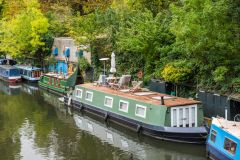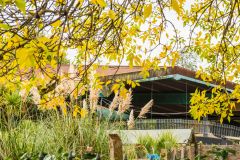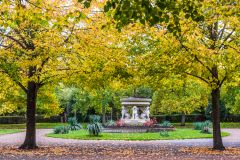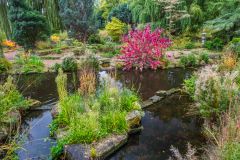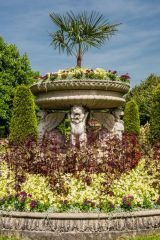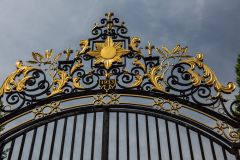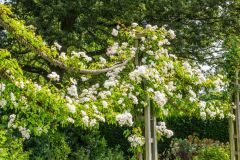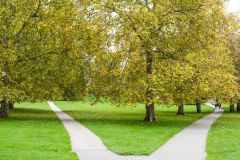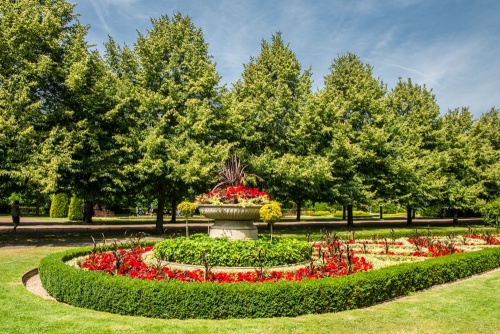
There are eight royal parks in London, and of these Regent's Park is known as the 'jewel in the crown'. The park stretches from Marylebone in the south to Camden in the north and from Somers Town in the east to St John's Wood in the west.
History
Regent's Park began as a royal hunting ground under Henry VIII and was known as Marylebone Park until 1646. The park that we see today was the brainchild of the fashionable Regency architect John Nash. Nash was a close friend of the Prince Regent, the future George IV and here he designed a vast setting of gardens, lakes, canals, and residential terraces surrounding a summer palace for the prince.
Nash's ambitious plan included 58 elegant villas. Only eight were ever built, and plans for the Prince Regent's palace were abandoned, but you can still see two of Nash's elegant villas within the park (St John's Lodge and The Holme).
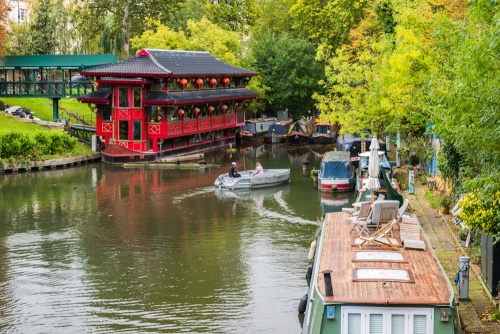
Regent's Park was not a public green space as it is today, but an enclave for the wealthy and prestigious organisations. One of the organisations was the Zoological Society, whose headquarters eventual became ZSL London Zoo. Another organisation to call the park home was the Royal Botanic Society.
The park was not opened to the public until 1835, and then only for two days each week. It was not until Queen Mary's Garden was created in the 1930s that Regent's Park was fully opened to the public.
Regent's Park - What to See
Jubilee Gates
This ornate gilded iron gateway was installed at the southern edge of the Inner Circle, opposite York Bridge, to commemorate the Silver Jubilee of King George V in 1935 and to simultaneously mark the opening of Queen Mary Gardens. The gates act as the ceremonial entrance into the gardens.
Jubilee Gates were given by Sigismund Goetze, a wealthy artist who lived in what is now Nuffield House, on the northern edge of the park for 30 years from 1909-1939.
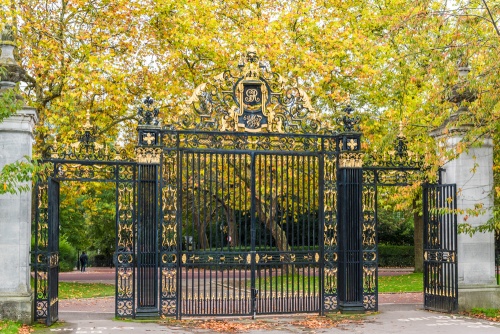
Ready Money Drinking Fountain
Acting as an exclamation point at the northern end of the Broad Walk is Ready Money Fountain, an ornately carved Victorian Gothic drinking fountain erected by Sir Cowasjee Jehangir, a wealthy Parsee businessman from Mumbai (Bombay). Jehangir's nickname was 'Ready Money'.
He gave the fountain to Regent's Park in 1869 in gratitude for the protection offered to him and other Parsees by the British in India. The remarkable fountain is sculpted from four tonnes of Aberdeen granite and ten tonnes of red Sicilian marble.
The fountain includes rather cute ground-level drinking troughs for dogs. It was unveiled by Princess Mary of Teck, later Queen Mary after whom the Queen Mary Gardens are named.
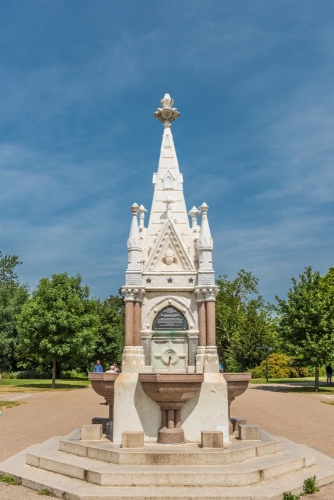
Triton Fountain
At the northern edge of the Inner Circle stands a striking group of bronze statues acting as the centrepiece of a large fountain. The sculptures depict a sea god (Triton) blowing a conch shell while a pair of mermaids kneel at his feet. The sculpture was the gift of Sigismund Goetze's wife, installed in his memory in 1950 (see Jubilee Gates, above). Mrs Goetze also gave fountains to Hyde Park and Green Park.
The fountain stands on the former site of a conservatory owned by the Royal Botanical Society, who used to own the site.
The sculpture was designed by William McMillan, who was also responsible for one of the fountains that grace Trafalgar Square.
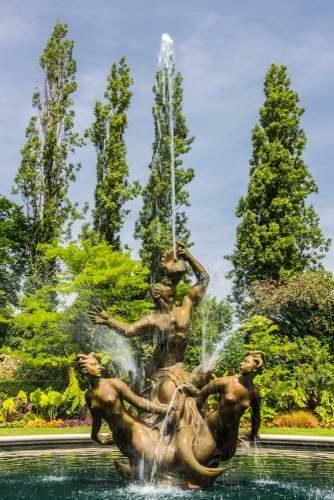
Boy and Frog Statue
This statue is in the middle of a pond in Queen Mary's Garden. It shows a boy and frog sitting on a plinth carved from Finnish granite. The statue was designed by Sir William Reid Dick and donated to the garden by the artist Sigismund Goetze (see the Jubilee Gates and Triton Fountain above).
Hylas and the Nymph Statue
Within St John's Lodge Garden, north of the Inner Circle, is a Grade II listed bronze sculpture of a boy (Hylas) and a mermaid (the Nymph). The figures stand on a pedestal in the centre of a small pond. The statue was designed by Henry Pegram and given by the Royal Academy of the arts in 1933.
The sculpture was inspired by the Greek myth of Jason and the Argonauts, who sailed off in search of the Golden Fleece. Hylas was one of the Argonauts. During the voyage, Hylas was kidnapped by the Nymph of Spring and was never seen again.
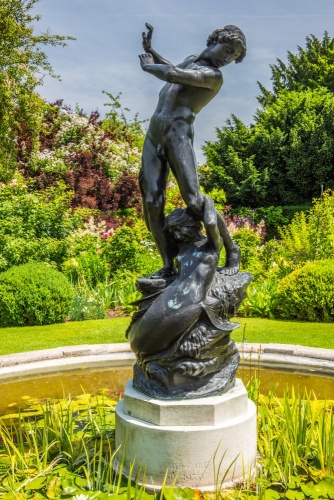
The Bandstand
Between the Inner Circle and the boating lake stretches Holme Green, a wide lawned area. Here you will find Regent Park's Grade II listed bandstand. The bandstand originally stood in Richmond Park but was moved here in the 1970s.
In 1982 the IRA set off a bomb near the bandstand during a concert featuring the band of the Royal Green Jackets. The bomb killed seven soldiers and injured 24 more. A plaque commemorates the dead band members, and the bandstand is sometimes known as the Memorial Bandstand in their memory.
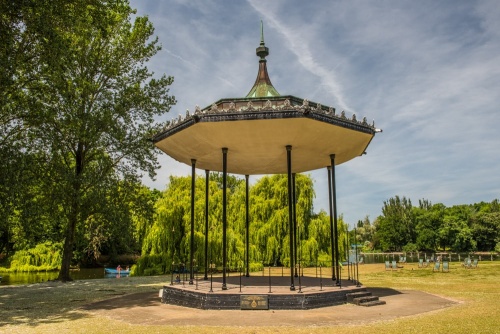
Avenue Gardens
Running north to south through the south-eastern half of the park is Avenue Gardens, just south of the Broad Walk. This area of the park was originally laid out by John Nash to be just like Broad Walk, with eight rows of trees. While thee trees lining Broad Walk thrived, the ones here did not.
Expert gardeners were called in to remedy the situation, among them William Andrews Nesfield, who recommended that Nash's design be abandoned in favour of a new formal garden layout including fountains, formal flower beds and sculptures.
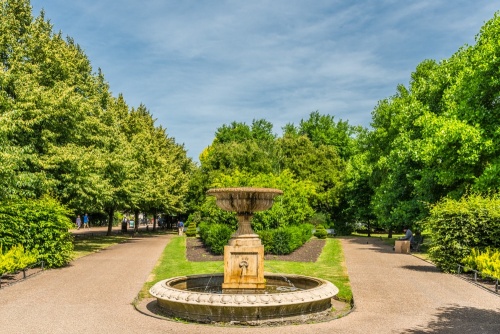
Griffin Tazza (Lion Vase)
The result is a delight, and one of London's most enjoyable formal gardens. The centrepiece of Avenue Gardens is the Griffin, or Lion Vase (sometimes called the Lion Tazza), a large circular sculpture of a bowl supported by four stone lions. The sculpture was designed by Nesfield and installed in 1863. It is one of 30 stone vases in Avenue Gardens, and easily the most impressive.
Avenue Gardens is bordered by evergreen hedges and dotted with huge stone bowls filled with flowers. Tiered fountains add water to the colourful scene. This is one of our favourite parts of Regent's Park.
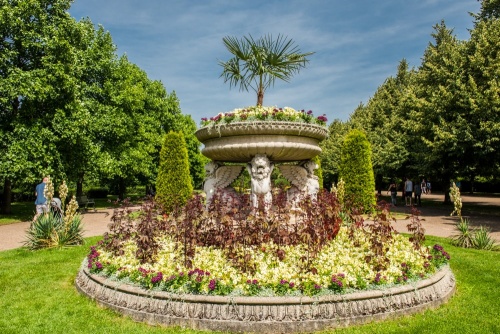
Queen Mary's Garden
If Regent's Park has a focal point it is Queen Mary's Garden, named for Mary of Teck, the wife and Queen Consort of King George V. The garden opened in 1932. One highlight is a formal rose garden (at its best in June). This is the largest collection of roses in London, with over 12,000 individual flowers. There are 85 beds planted with a single variety of roses. One of these varieties is the Royal Parks rose.
Aside from the formal rose garden there is a National Collection of Delphiniums, a begonia garden, and colourful Mediterranean Borders.
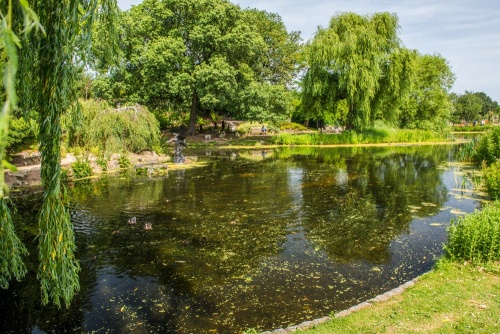
St John's Lodge Garden
Queen Mary's Garden is enclosed within a ring road known as the Inner Circle. Outside the northern boundary of the Inner Circle is St John's Lodge Garden, created in 1889 by Robert Weir Shultz as a space for quiet meditation. The garden is dotted with pieces of sculpture including the Hyla and the Nymph statue mentioned above.
Another statue within St John's Lodge Gardens is the Goatherd, a bronze statue of a woman carrying a goat. Designed by Charles Leonard Harwell, the statue was erected by the National Council for Animal Welfare in 1932.
The garden stands beside St John's Lodge, a private residence built in 1818 by John Raffield and enlarged several decades later by Sir Charles Barry, the architect of the Palace of Westminster. The property was later purchased by the immensely wealthy 3rd Marquess of Bute, who called in Robert Weir Shultz to lay out the garden we see today.
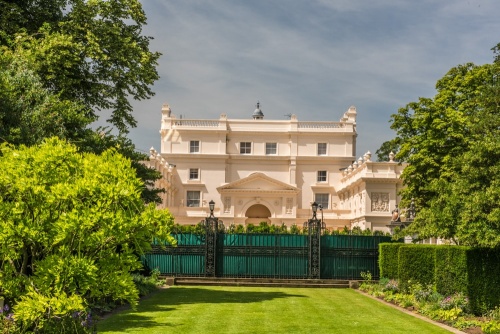
Open Air Theatre
In the north-west corner of the Inner Circle is the Open Air Theatre, a London landmark and the oldest professional permanent outdoor theatre in Britain. The theatre was founded in 1932 and welcomes over 140,000 theatre-goers each year to its seasonal offerings. Both the seating area and the stage are completely uncovered. We had the pleasure of attending a 'Shakespeare in the Park' performance here years ago and it was an extremely enjoyable experience.
ZSL London Zoo
On the northern edge of Regent's Park, just inside the Outer Circle, is London Zoo, housing 755 individual species of animals, making it among the largest zoos in the UK. The zoo's prefix ZSL stands for the Zoological Society of London, who manage the site. There has been a zoological garden here since 1828, making this the oldest scientific zoo in the world. The zoo was designed by architect Decimus Burton, the man who designed the Wellington Arch.
Primrose Hill
Separated from the main body of Regent's Park by Prince Albert Road (the A5205) is Primrose Hill, which rises above the park on its northern boundary. Whereas Regent's Park is relatively flat and divided into formal areas, Primrose Hill has a much more informal atmosphere.
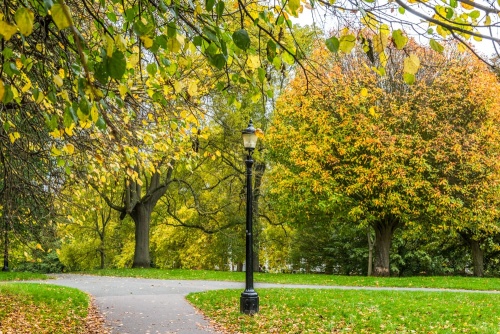
Primrose Hill - History
Like Regent's Park itself, this area was once part of Henry VIII's royal hunting ground.
By the 19th century, the land was owned by Eton College. In 1841 an ambitious plan was mooted by George Carden to convert the land into a cemetery to rival the Pere Lachaise burial ground in Paris. The centrepiece of Carden's ambitious plan was to be a gigantic pyramid of bricks, designed to hold exactly 5,167,104 bodies. The pyramid would have been taller than St Paul's Cathedral.
London certainly needed more burial grounds, but Eton College was not impressed with the plan. Instead, they gave the land to the Crown, in exchange for crown-owned land that part of the College was built on. Parliament immediately made the newly-acquired land into a public park, a green space for the poor residents of north London providing a much-needed recreational area.
Before it became a public park Primrose Hill was a place with a dubious reputation. It was a popular spot for duels and a venue for prizefights. The 16th-century prophetess Mother Shipton foretold that if London ever encroached on the boundaries of Primrose Hill then disaster would befall the city.
She used slightly more colourful language, saying 'When London surrounds Primrose Hill, the streets of the metropolis will run with blood.' London certainly has surrounded Primrose Hill, but thankfully there are no signs of the nearby streets running with blood.
There was blood in 1678 when the body of Sir Edmund Berry Godfrey was found in a ditch at the base of the hill, skewered on his own sword. No one knew who had killed Godfrey, but he was a vociferous Protestant, and his murder gave credence to the Popish Plot, a fictional Catholic conspiracy to kill King Charles II. Anti-Catholic sentiment boiled over and in the ensuing violence, some 22 people were killed.
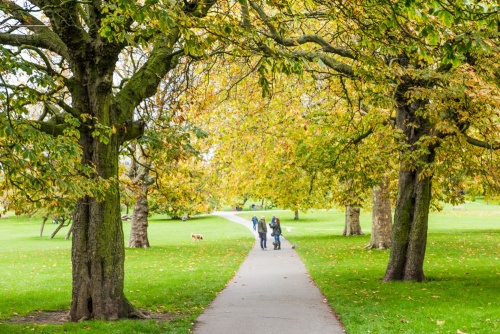
A Fictional Setting
Two popular works of fiction use Primrose Hill as a setting. In HG Wells' work 'The War of the Worlds', the aliens make their final stand on Primrose Hill. Wells knew the area well, having lived for a time on nearby Fitzroy Road.
The second novel to use Primrose Hill as a setting is quite different from Wells' account of an alien invasion. The Hill is a setting for Dodie Smith's 1956 children's book 'The Hundred and One Dalmatians'. In the novel, John Darling takes his dogs for a walk on Primrose Hill each day, and it is from the summit of the hill that the dogs send messages about their missing puppies via the 'Twilight Bark'.
When we visited Primrose Hill in the late afternoon my wife was keen to stand on the summit and do her best Dalmatian bark imitation in honour of the book. I pointed out that it wasn't twilight yet, and she might feel funny standing there barking, surrounded by about 100 people enjoying the afternoon breeze. She kept her bark internal.
The view from the top of Primrose Hill towards London and the River Thames is one of six protected views in Greater London. What that means in practice is that trees are kept trimmed to allow the full panorama of London to spread out before you. This is probably the best place in London to watch the sunset or, if you are an early riser, watch the sun come up over the city.
Primrose Hill - What to See
Shakespeare's Tree
On the slope of Primrose Hill, below the summit, stands an oak tree planted in 1964 to mark the 400th anniversary of William Shakespeare's birth. The tree replaced an oak planted exactly 100 years earlier on the 300th anniversary of the 'Bard of Avon's' birth. An estimated 100,000 people turned up to watch the original tree being planted.
The replacement tree was made necessary when the original tree died. Unfortunately, it is very hard to identify Shakespeare's Tee, as our family can attest, because it is not marked by a plaque. The original plaque was stolen and never replaced.
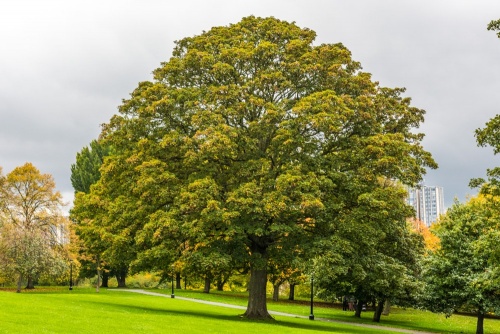
Iolo Morganwg Memorial
On the summit of Primrose Hill is a plaque to Iolo Morganwg (Edward Williams) who founded the Gorsedd of Bards of the Island of Britain. The Bards are a group of Welsh writers, poets, artists and musicians who have contributed to Welsh culture.
They held their first meeting on Primrose Hill in midsummer's day, 21 June 1792. The gathering launched what is now the annual National Eisteddfod, a celebration of Welsh language and culture held at a different location each year.
Iolo Morganwg was a political activist, writer, and poet. He also helped establish the Unitarian Church in Wales.
The memorial consists of a square plaque within a circular arrangement of stones, set into the ground on 21 June 2009, on the 215th anniversary of the Gorsedd's meeting on this spot.
The Iolo Morganwg memorial stands within a paved area with benches and a low stone wall inscribed with a verse from the poet William Blake, 'I have conversed with the spiritual sun. I saw him on Primrose Hill.'
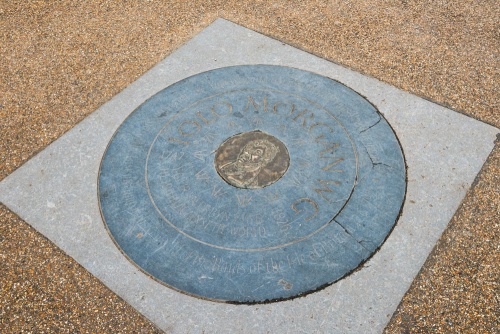
Getting There
The easiest way to reach Primrose Hill by public transport is to take the Northern Line (Edgware branch) to Chalk Farm. From the station, walk west along Adelaide Road to Primrose Hill Road. Turn left, cross King Henry's Road and you will see a gate into Primrose Hill across the road on your right.
Several tube stations serve the southern end of Regent's Park. The closest to the park are Baker Street and Regents Park, both on the Bakerloo line. The closest tube station to ZSL London Zoo is Camden Town (Northern Line).
There are three car parks in the park, two on Inner Circle and one on Chester Road.
About Regent's Park
Address: Regent's Park Office, The Store Yard, Inner Circle, London,
Greater London,
England, NW1 4NR
Attraction Type: Countryside - Royal Park
Location: The closest underground stations are Baker Street and Regent's Park (Bakerloo Line) for Regent's Park, and Chalk Farm (Northern Line) for Primrose Hill.
Website: Regent's Park
Email: regents@royalparks.org.uk
Location
map
OS: TQ281825
Photo Credit: David Ross and Britain Express
Nearest station: ![]() Baker Street - 0.4 miles (straight line) - Zone: 1
Baker Street - 0.4 miles (straight line) - Zone: 1
POPULAR POSTS
HERITAGE
 We've 'tagged' this attraction information to help you find related historic attractions and learn more about major time periods mentioned.
We've 'tagged' this attraction information to help you find related historic attractions and learn more about major time periods mentioned.
Find other attractions tagged with:
NEARBY HISTORIC ATTRACTIONS
Heritage Rated from 1- 5 (low to exceptional) on historic interest
Sherlock Holmes Museum - 0.3 miles (Museum) ![]()
ZSL London Zoo - 0.6 miles (Family Attraction) ![]()
Asia House - 0.6 miles (Museum) ![]()
Wallace Collection - 0.7 miles (Museum) ![]()
Fitzroy House - 0.7 miles (Historic House) ![]()
Jewish Museum - 0.8 miles (Museum) ![]()
All Soul's Church Langham Place - 0.8 miles (Historic Church) ![]()
Grant Museum of Zoology - 0.9 miles (Museum) ![]()
Nearest Holiday Cottages to Regent's Park:
Leaves Green, Greater London
Sleeps: 6
Stay from: £871 - 3614
More self catering near Regent's Park
